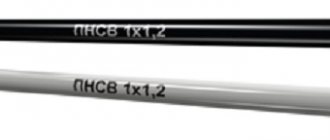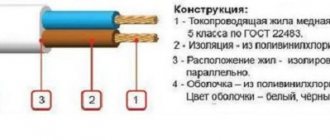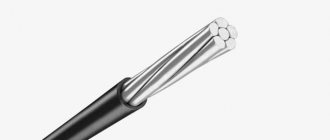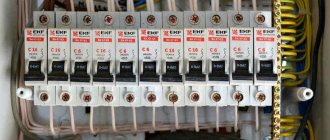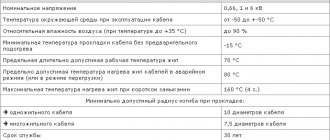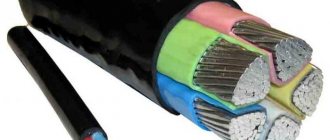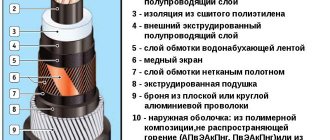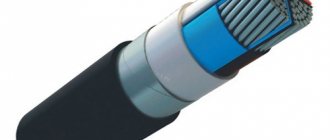The parameters of the PVA electrical wire are taken into account in detail when designing repairs or construction of facilities where the laying of an extensive infrastructure is required. Then every criterion is important. For example, the weight of the PVA determines how many fasteners will be needed to securely fix it to the structure. Or on the outer diameter of the PVA - what type of staples is needed to secure the cable tightly and at the same time not to pinch the insulating sheath.
Table 1. Main characteristics depending on the brand of PVS cable
| Number of cores, pcs. | Number of wires and diameter, pcs. and mm | Outer diameter of wire, mm | Section, mm2 | Weight of 1 km of wire, kg | Electrical resistance of cores, Ohm/km | Load current, no more than, A |
| 2 | 24x0.20 | 6,4 | 0,75 | 58 | 26,0 | 6,0 |
| 2 | 32x0.20 | 6,7 | 1,00 | 67 | 19,5 | 10,0 |
| 2 | 30x0.25 | 7,7 | 1,50 | 89 | 13,3 | 16,0 |
| 2 | 50x0.25 | 9,6 | 2,50 | 141 | 7,98 | 25,0 |
| 3 | 24x0.20 | 6,8 | 0,75 | 69 | 26,0 | 6,0 |
| 3 | 32x0.20 | 7,1 | 1,00 | 79 | 19,5 | 10,0 |
| 3 | 30x0.25 | 8,4 | 1,50 | 110 | 13,3 | 16,0 |
| 3 | 50x0.25 | 10,3 | 2,50 | 175 | 7,98 | 25,0 |
| 4 | 24x0.20 | 7,4 | 0,75 | 83 | 26,0 | 6,0 |
| 4 | 32x0.20 | 7,9 | 1,00 | 100 | 19,5 | 10,0 |
| 4 | 30x0.25 | 9,4 | 1,50 | 137 | 13,3 | 16,0 |
| 4 | 50x0.25 | 11,3 | 2,50 | 212 | 7,98 | 25,0 |
| 5 | 24x0.75 | 8,3 | 0,75 | 101 | 26,0 | 6,0 |
| 5 | 32x0.20 | 8,7 | 1,00 | 118 | 19,5 | 10,0 |
| 5 | 30x0.25 | 10,5 | 1,50 | 167 | 13,3 | 16,0 |
| 5 | 50x0.25 | 12,6 | 2,50 | 258 | 7,98 | 25,0 |
Let's add a little explanation to the parameters included in the table. So, the number of cores is selected based on the connected equipment and network voltage. For example, 2 wires are suitable for working with a single-phase 220V network without grounding. If the latter is available, use a three-core cable. If you need a connection to a three-phase 380V network, you need a wire with 4 or 5 cores, depending on the presence of a ground loop.
What is a PVS wire and its decoding
Based on the name, this is a wire (this is indicated by the first letter - P), enclosed in polyvinyl chloride insulation (the second letter in the abbreviation - B), used as a connecting wire (C). Below is a table that shows the characteristic features for various types of this wire, in accordance with the systematization according to GOST 7399-97.
Systematization table.
| Name | Form | Design features | Characteristics | ~Unom | ||
| Number of cores | Flexibility | Type of insulation and sheath | ||||
| PVS | round | 2-5 | flexible | PVC | — | 380 V |
| PVS ng | PVC | Group installation allowed | ||||
| PVS ng-LS | Low smoke emission PVC | Group installation allowed | ||||
| PVSP | flat | 2 | PVC | — | ||
Marking is carried out according to the following principle: [TYPE] [number of cores] – [cross-section]. It is applied to the outer shell.
Example of PVS wire marking
Reasons for prohibiting use
The use of PUNGP is prohibited, since Russian GOST does not regulate the production of these products. In TU 16.K13-020-93 with the cable characteristics there is a point that allows a run-up across the cross-sectional area of up to 30%. Manufacturers do just that in order to reduce selling prices. As a result, after purchasing a material with a nominal cross-section of 2.5 mm2, it turns out that the cross-section does not even reach 2 mm2. Experienced electricians check the cable with a caliper, but home craftsmen install it into a network whose load will be critical for a thin cord.
The thickness of the PUNGP insulating layer is not suitable for modern standard electrical conductors. They are produced with a shell thickness from 0.4 to 0.5 mm; the specifications indicate a different figure - 0.3 mm.
Users purchase PUNGP cable products due to their low cost, without focusing on fire safety and the non-compliance of a number of characteristics with regulatory standards. To prevent fires in the wiring, it is worth laying the cable only indoors in a pipe or corrugation
The parameters of the cores should be measured in the store, paying attention to the color marking of the cores and the thickness of the outer sheath
PVS wire design
The structure of the wire can be called typical; as an example, Figure 1 shows the design of a three-wire PVS.
PVA wire design
Designation:
- A – conductors, they are made from twisted wires, copper is used as the material.
- B – insulating coating of the cores; polyvinyl chloride resin and special additives are used for its production to increase ductility and improve performance characteristics.
- C – outer covering (this insulation is made of the same material as for the cores).
Speaking about insulation, it is necessary to talk about accepted color standards.
Video description
The video will tell you more about the color marking of wires for single-phase and three-phase networks:
To install high-quality wiring in a house that will correspond to the network voltage, current loads and operating conditions, you need to choose the right wiring products for each area. After all, to connect a light bulb in the bathroom and an electric oven in the kitchen, you need products with different characteristics. Knowing the brands of cables and knowing how to read them, this will be easy to do.
Accepted colors
The above GOST does not impose any special requirements for the coloring of external insulation; 10 color options are allowed: white, black, gray, etc.
As for the color of the core insulation, it must correspond to the table below.
The color chart for insulation is live depending on their purpose and quantity:
| Number of cores | Accepted color standard | |
| there is a grounding conductor | No grounding conductor | |
| 2 | brown, blue | |
| 3 | yellow-green, brown, blue | black, brown and blue |
| 4 | yellow-green, black, brown, blue | blue, black, brown, black or brown |
| 5 | yellow-green, blue, black, brown and black or brown | blue, black, brown, black or brown, black or brown |
The purpose depending on the color of the insulation is shown in Figure 3.
Figure 3. Colors according to GOST for neutral, protective and phase conductors
Please note that sometimes the insulation of the phase conductor is also white, which is acceptable according to the international standard.
Having finished with the design features and color designation, let's move on to the description of the main parameters.
Marking
For existing brands of PVC, the decoding of designations has the following standards (GOST 7399-97):
- Tinned copper as phase wires - PVSL;
- Antiseptic additives in the insulation material - PVST;
- The flat section of the outer insulating layer is “ShV”;
- Reinforced outer protective shell - “B”;
- The insulation material has increased combustion resistance - “PS”.
In addition to the letter code, the PVC cable marking contains numbers, which are deciphered in the following order:
- The number of conductors is indicated by the first digit.
- After the “x” icon follows the cross-sectional area of 1 core in millimeters:
| Two-core | Three-core | Four-core | Five-core |
| 2x2.5 | 3x2.5 | 4x2.5 | 5x2.5 |
| 2x1.5 | 3x1.5 | 4x1.5 | 5x1.5 |
| 2x1 | 3x1 | 4x1 | 5x1 |
| 2x0.75 | 3x0.75 | 4x0.75 | 5,0,75 |
The same numbers indicate the weight of 1 km of the product:
| 0.75 mm² | 0.1 mm² | 1.5 mm² | 2.5 mm² | |
| Two-core | 55.8 kg | 66.1 kg | 79.8 kg | 102 kg |
| Three-core | 63.7 kg | 76.5 kg | 96.5 kg | 118.4 kg |
| Four-core | 85.15 kg | 107 kg | 134.5 kg | 170.6 kg |
| Five-core | 133 kg | 166.7 kg | 203.8 kg | 257.6 kg |
Technical characteristics and operating conditions
According to the current GOST, this type of wire must meet the following standards:
- The lower limit of the operating temperature range is 20°C below zero, permissible long-term heating is 40-50°C, short-term heating is not more than 70°C. Frost-resistant design is possible, in this case the lower threshold drops to -40°C.
- The rated voltage is 380 V, but the insulation must withstand a short-term increase of up to 2000 V (at least 5 minutes). It is under these conditions that tests should be carried out by the manufacturer.
- PVA insulation of any type should not spread fire if a single installation was carried out. When laying in groups, this requirement applies only to wires marked “ng” in the marking.
- Failure-free operating time in hours is at least 5000; when used in stationary installations, this parameter increases to 12000; in years this is 6 and 10 years, respectively.
- The threshold of permissible relative humidity should not be lower than 98%.
- Mandatory resistance to the destructive effects of fungi and mold.
The remaining parameters are shown in the table below.
Additional designations
The PVS cable is produced in a basic version, but there are modifications used in special conditions. The marking has an additional letter.
- U – extended temperature range, operation is allowed down to -40C°;
- L – tinned copper conductors, improving protection against corrosion;
- Ng – does not support combustion;
- LS (or d) – plasticizer, provides reduced smoke emission.
Application
Actually, the scope of application is indicated in the name - “connecting wire”. Its main purpose is to connect to the network various stationary or mobile (portable) electrical equipment powered by a voltage of no more than 380 V.
Given the flexibility of this type of wire, it is excellent as a household extension cord.
Household extension cord
But it must be taken into account that PVA insulation is not designed for outdoor use. It breaks down under ultraviolet radiation and is susceptible to moisture.
Now let's move on to the question of using PVA when installing electrical wiring. This is not what you can do. To immediately exclude the argument, which indicates the absence of a direct prohibition in the PUE. Let us provide excerpts to put an end to this dispute.
Excerpts from SP and PUE
This alone is enough to cause problems when obtaining insurance in the event of a fire in an apartment or house.
Please note that according to the above excerpts, installation with PVS ng wire is allowed. But there are the following arguments against this option:
- Pay attention to the service life, even for stationary installations it is 12 years; further, the insulation’s preservation of its properties is not guaranteed. Wiring laid with VVG cable will last almost three times longer.
- PVS ng is more expensive than VVG.
The above arguments are quite sufficient to demonstrate the absurdity of such a decision.
Where is it used?
In fact, there are no strict restrictions on the use of this type of cable. It can be installed both for lighting and for connecting electrical installations. It is also used in machines where various electrical components and mechanisms are connected. Why such a wide range of applications? The whole point is that:
- mounting wire PV 3 has sufficiently high strength, so it can withstand mechanical loads well;
- colonies of microorganisms do not form on it, which negatively affect the quality of the product;
- PVC insulation is self-extinguishing;
- installation wire PV 3 or 1 has minimal linear expansion.
This brand of cable can be laid in trays, pipes (metal or plastic), in special channels located in the structural elements of buildings, inside installations and machines. The yellow-green cable is used in grounding loops.
Wire design
Installation features
They are the same as those of other copper stranded conductors. When connecting to plugs, automatic machines or other devices, the insulation is removed from the ends of the wire, the wires are tinned or crimped with special lugs.
Tips and crimping tools
If you have the necessary tools, the crimping technology is quite simple, the algorithm of actions is as follows:
- A layer of external insulation will be removed (approximately 12-15 mm).
- The ends of the conductors are also freed from the insulating sheath at a distance of 10-13 mm from the edge.
- A ferrule is put on the end of the wire and crimped with press pliers (you can see what they look like above).
The procedure can be significantly speeded up if you use special pliers to remove the insulation.
With the help of these tools, the crimping process is done in a matter of minutes, quickly and in accordance with the standards. Just in case, we remind you that the PUE does not know what twisting is.
Video description
Examples of decoding alphanumeric symbols can be seen in the following video:
Wire designations
The wires are also marked according to a similar scheme, but the number of characters in their code is smaller, so it is easier to “unravel” it. Detailed marking of cables and wires - explanation in the table:
As in the examples with cable decoding, the numbers after a series of letters indicate the number of bare cores in the wire (if there are many) and the size of their cross-section.
Examples of the most popular and frequently used wires are in front of you.
Characteristics and purpose of popular wiresSource samelectrik.ru
How to choose PVS wire?
First of all, you need to decide on the number of cores; there can be from two to five. In everyday life, as a rule, a three-wire wire (phase, neutral, ground) is sufficient. Having solved this issue, the cross section is selected depending on the power of the connected equipment. In order not to bother with calculations, we present the recommended wire cross-section, depending on the load current:
Table of permissible maximum current for typical cross-sections of PVA wire cores.
| Core cross-section (mm2) | Imax(A) |
| 0,75 | 6,0 |
| 1,00 | 10,0 |
| 1,50 | 14,0 |
| 2,50 | 20,0 |
Given the emergence of a large number of counterfeit products, be sure to check for a certificate of conformity before purchasing.
As for manufacturers' recommendations, it is difficult to give a definite answer to this question without it sounding like advertising. If they comply with GOST, any product will meet the task.
Cable cross-section
The selection of wiring for a wooden house or apartment is made from those available with copper conductors, with a minimum cross-section of 1.5 mm². It characterizes throughput. For such elements, 1 mm² transmits 8-10 A, and for aluminum ones - only 5 A. The calculation of electrical wiring lines in a private house or other building is carried out separately according to the load, after which the cable cross-section is selected.
Watch this video on YouTube
The table shows the cross-sections used for home electrical wiring (VVGng-LS cable).
| Purpose | Section, mm² | Maximum power, kW | Recommended rating of the protective circuit breaker, A |
| Lighting | 3x1.5 | 4,1 | 10 |
| Sockets | 3x2.5 | 5,9 | 16 |
| For electric stove or hob | 3x6 | 10,1 | 32 |
Input wiring to the apartment is carried out with a cross-section of 3x6 mm². Selected by power and current.
The buyer must understand that cross-section and diameter are different concepts. The first is the area of the circle, calculated as 0.785 square of the diameter. This figure is always rounded up when purchasing.


